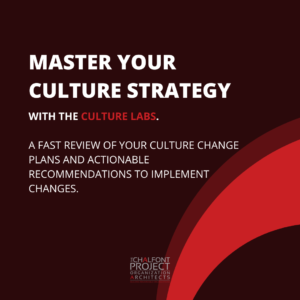Culture is in the A list, the one where ‘work’ sits. Not in the B list (‘when I have time, after A’).
Culture is not a project, something to do on top of normal work, an extra, something to get your hands around once the big stuff has been done.
Certainly culture is not an ‘HR function topic’ but a business one, with all the help of HR and non HR that you can get.
Culture is a big word, with similar liabilities as ‘change’: overused, prompt to cynicism, multiple use, a thousand meanings.
Culture is the how you do the what, the platform for your success or failure.
So, how can you create and sustain the culture you want?
Behaviours create cultures. Master behaviours, agree upon them, declare the non negotiable ones, spread them, and you’ll get culture.
Culture cannot be taught. It’s something lived, and, in behavioural terms, something that grows from behaviours. Behaviours scale up via social influence, so suddenly you have a causal link between behaviours, influence and culture. Get the first two right, you get a great third.
Most problems with cultures come from decoupling the idea of culture from ‘the real stuff’:
- operations
- compliance
- targets
- performance
Culture is business. Business is culture. Stuck to each other with super glue. Behaviours are the super glue.
Culture, still a big thing, needs to be unpacked further. Chances are you don’t have one corporate culture, no matter how much you preach that. You have subcultures overlapping in a Venn diagram. My rule of thumb is to start from the subcultures upwards, not the other way around. Form your views bottom up. Instead of ‘this is the culture, let’s look deeper’, start with what the engineers do, the finance people do, the sales ones do. Then join up.
Rethinking the role of Leadership
You may also have a sub-subculture in a perhaps almost self-contained territory called the Leadership Team. Conventional wisdom says that they represent the corporate culture. My unconventional-less-wisdom says that most of the time they represent themselves, their own ecosystem, their own island.
Dysfunctional leadership teams seem to coexist with rather healthy and successful subcultures, and some dysfunctional organizations seem to have a good functional top. And combinations.
Ah! I wish something could correlate with anything in the organizational world.
As leader, I have a strong recommendation: don’t be shy to talk about culture. If people begin yawning, wake them up. If they smile, smile back and ask why. If they say ‘here we go again’, stop and have a conversation.
As leader you will probably not be shy to talk about performance. Apply the same to culture. Leaders are curators of cultures. And all this is happening in the A list of things. Not the B.
____________________________________________________

We have a simple vehicle to address your culture challenges. In just 2-3 months we will get to the bottom of your culture issues and provide you with a carefully crafted action plan.
Our expert consultants have transformed multinational organizations for 20+ years, and are ready to support you in accelerating your strategy through culture change.
Do you want to learn more?
Book a short, explorative call with my team via (+44) 01895 549158 or [email protected].



Would you like to comment?